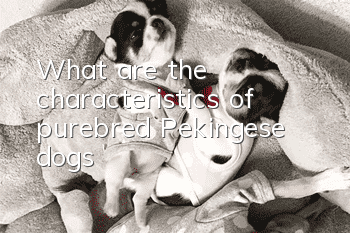What are the characteristics of purebred Pekingese dogs?

Head: The skull is broad, the ears are far apart and flat; not round; the eyes are far apart.
Face: flat in appearance, with the nose naturally turned upward from the eyes. There should be dark spots on the nose, lips and eye frames.
Nose: short and wide, nostrils large and open. A wrinkle, whether it is continuous or disconnected, must extend from the cheek to the bridge of the nose, resembling a wide "V". This feature in turn must not affect or impede the eyes or nose. Tight nostrils and excessive nose wrinkles are disqualifying.
Muzzle: Broad, with strong jaw. Lips: Flat lips, no teeth or tongue exposed. The jaw must be strong.
Eyes: large, bright, round, black and shiny. There can be no obvious problems.
Ears: The drooping part is heart-shaped. The ear position is level with the skull. When raised, it is close to the head and cannot be lower than the muzzle line. The feathers are long and abundant.
Limbs: Forequarters are short, thick, and strong-boned. The bones of the forelegs between pasterns and elbows are slightly arched. The shoulders are slanted back and smoothly connected to the body. The elbow must be close to the body.
Hindquarters: The hind legs are lighter than the front legs. Properly flexed, with obvious stifle joints. Hocks strong. When viewed from behind, the legs are well spaced and parallel. Must be very strong.
Feet: Large, flat, not round. Stand naturally on your feet, not on your bones. The front feet are turned slightly outward. The back foot points straight forward.
Tail: set high, slightly curved over the back and long-feathered.
- Is it better for Dogo dogs to have their ears erect or cropped? A case of Dogo dog’s ear erection surgery will tell you
- What do dogs eat to protect their stomach? It is important to protect their stomach and treat gastrointestinal diseases in dogs.
- How to tell if your dog is fat? Is your dog overweight?
- How to train Tibetan Mastiff Four aspects teach you how to train Tibetan Mastiff
- Will your dog catch a cold if you blow the air conditioner? What should you do if your dog catches a cold if you blow the air conditioner?
- What should you pay attention to when your dog drinks water? Don’t be careless when it comes to your dog’s drinking water.
- The dog's mouth bites and shakes. Why does the dog's mouth occasionally shake and bite?
- How to cut a dog's hair? Do you know how to cut a dog's hair correctly?
- Can dogs eat raw eggs? Why can’t dogs eat egg whites?
- Common Dog Problems in Summer How to Deal with Different Dog Problems



